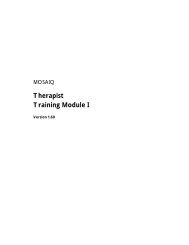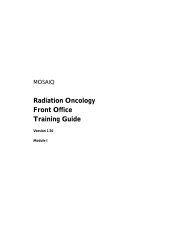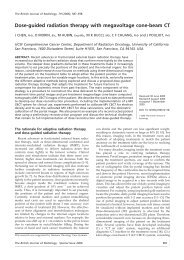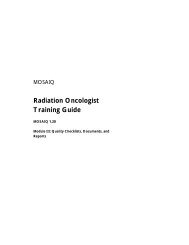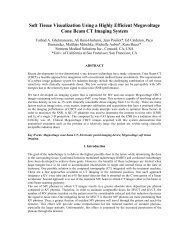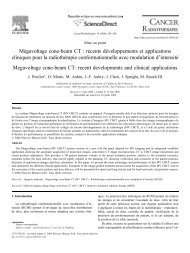IB Senior Educational Objectives - UCSF Radiation Oncology
IB Senior Educational Objectives - UCSF Radiation Oncology
IB Senior Educational Objectives - UCSF Radiation Oncology
Create successful ePaper yourself
Turn your PDF publications into a flip-book with our unique Google optimized e-Paper software.
Rev. 9/14/10<br />
9. Brainstem (from the cerebral peduncles to the foramen magnum)<br />
10. Bilateral Parotids<br />
11. Spinal Cord (from the foramen magnum to C2)<br />
ii. Spine Cases:<br />
1. Tumor (or surgical bed); GTV, CTV, and PTV (as indicated)<br />
2. Spinal cord (two vertebral body levels above and below the target)<br />
3. Relevant, treatment-level specific surrounding normal tissue<br />
structures (e.g. small or large bowel, heart, lungs, thyroid, etc.)<br />
h. Calculate dose-volume histograms, both differential and cumulative, and understand<br />
the relevant thresholds.<br />
i. Become familiar with management of acute and late radiation reactions (e.g. radiation<br />
necrosis)<br />
j. Document in Lantis (or equivalent department medical record system) the following:<br />
i. Date of initial diagnosis<br />
ii. Date of consultation<br />
iii. Treatment site (ICD-9 code)<br />
iv. Tumor stage/grade information<br />
v. Histology<br />
vi. Simulation note, describing simulation position, immobilization devices, type<br />
of simulation (PET, CT, MR, or fluoroscopy), specific scan instructions (e.g.<br />
scan slice thickness, gap, +/- contrast etc.)<br />
vii. Treatment site, modality, energy, dose/fractionation<br />
viii. Notify medical physicist(s) if specific pre-treatment checks (e.g. TLDs) are<br />
required<br />
11. On-Treatment Patients<br />
i. Be aware of issues and status during treatment.<br />
ii. Maintain on-treatment list of patients; document on-treatment issues in<br />
Lantis (or equivalent electronic medical record system); notify attending of<br />
any patient-specific issues/complications<br />
iii. Check weekly port films with attending physician; respond to therapist<br />
inquiries regarding patient care issues<br />
12. Follow-up Patients<br />
i. See follow-up patients with attending physician; document follow-up visits in<br />
a clear, concise manner, and communicate with relevant services to ensure<br />
proper management and follow-up of patients (e.g. ensure follow-up visits<br />
with medical oncology for systemic therapy etc.)<br />
ii. Obtain recent test results, imaging and clinical notes on patients in advance<br />
of appointments and review with attending; this includes relevant medical<br />
records from outside medical facilities.<br />
13. Understand machine- and patient-specific QA practices for external beam<br />
treatments.<br />
14. Obtain training in emergency procedures of each treatment modality used (e.g.<br />
Gamma knife, Cyberknife, linear accelerator, and brachytherapy) and document<br />
proficiency.<br />
15. Final Examination (supervised)<br />
<strong>Senior</strong> resident is responsible for overseeing and leading the consultation,<br />
simulation, planning, plan evaluation, and treatment delivery of a definitive CNS<br />
treatment case (e.g. glioma, meningioma, etc.). The resident will be evaluated on<br />
5




